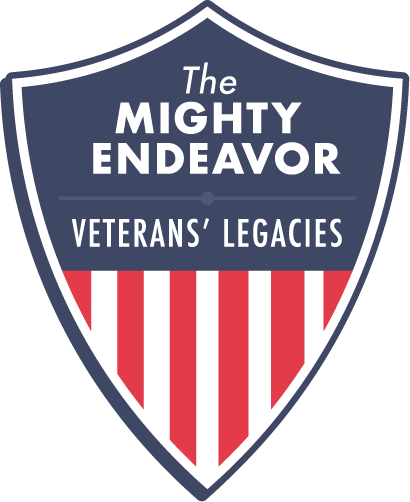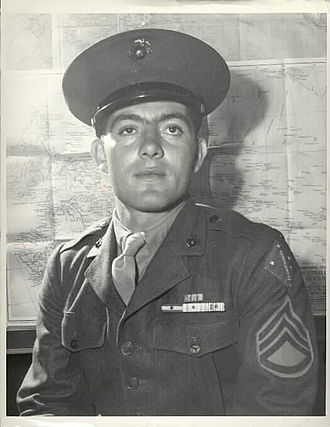John Basilone enlisted in the Marine Corps in June 1940 from Baltimore, Maryland. Before signing up with the Marine Corps, Basilone had had a three year enlistment with the US Army from which he was honorably discharged, and was stationed in the Philippines at the age of 18. Basilone wanted to return to the Philippines and assumed that being with the Marine Corps would get him there sooner, hence why he joined the Marines instead of re-enlisting with the army. Basilone had recruit training at the Marine Corps Recruit Depot on Parris Island, South Carolina, and then moved to regular training at the Marine Corps Base in Quantico, Virginia, and New River (now Camp Lejeune) in North Carolina. His first assignment not on US soil was to Guantanamo Bay, Cuba, but it was not long before he was transferred again. By 1942, he had been assigned to the Pacific Theater and was a part of the invasion of Guadalcanal along with his company, “D,” of the 1st Battalion, 7th Marines, 1st Marine Division. His fellow marines nicknamed him “Manila John” in reference to the time he spent in the Philippines and the fact that he wanted to go back there. It was here in Guadalcanal that Basilone earned the Medal of Honor.
On October 24 and 25, 1942, in the Lunga Area of Guadalcanal, Solomon Islands, Basilone and his squad were assisting with the defense of Henderson Field against a Japanese attack. Sergeant (Sgt.) Basilone and his unit went up against a regiment of about 3,000 Japanese troops with only two sections of machine guns. One of the sections was overcome by the enemy, but Basilone quickly made up for it. Without ceasing, Basilone operated and fixed the machine guns in his sections. As one private in his group recalled, “Basilone had a machine gun on the go for three days and nights without sleep” (Congressional Record). At one point, Basilone picked up a machine gun and its stand (about 90 pounds), moved it to a better position, and then used it, protecting his back (as by this point they had been cut off from the other troops) with his pistol. Basilone also retrieved more ammunition from behind enemy lines when they had gotten low because they had been cut off from the supply line. Basilone helped keep the line intact with only two other marines until replacement could arrive. At the end of the fighting, 38 bodies lay in the swathe of land covered by Basilone's machine gun. Basilone's flexibility during action and personal valor in risking his life displayed great courage as recognized by the Medal of Honor.
In 1943, Basilone returned to the US to participate in war bond tours. Due to his being a Medal of Honor recipient, his arrival was publicized and his hometown held a parade in his honor. In total, this tour raised $1.4 million in pledges. Basilone was featured on the cover of Life magazine and met many people of great importance and fame while on tour. He soon tired of touring and of his celebrity status, however, and requested to return to the front. He was denied the first time, but when he refused an officers commission and an instructor assignment in the US, the Marine Corps realized he was serious and accepted his next request to return to the front. He was transferred to Camp Pendleton in California for training before reentry. It was there that Basilone met his future wife, Lena Mae Riggi. She was a Sergeant in the Marine Corps Women's Reserve. They married on July 10, 1944. Before the end of that same year, Basilone was shipped off to the Pacific.
Basilone was promoted to a Gunnery Sergeant (Gy. Sgt.) and made the leader of a Machine-Gun Section of Company “C,” 1st Battalion, 27th Marine Regiment, 5th Marine Division. It was as a part of this division that Basilone returned to the front. He was in the first invasion of Iwo Jima of the Volcano Islands near Japan which occurred on February 19, 1945. Soon after landing, Basilone sized up the situation on the beach. Recognizing the futility of trying to move up the beach due to Japanese fire from blockhouses, Basilone moved his way along the flank of the Japanese defense while dodging bullets to get to the reverse side of a blockhouse (isolated forts, usually a single building, that serve as a strong defensive point; similar to a pillbox) where the Japanese would not expect the enemy. From this point, Basilone attacked the blockhouse using grenades and demolitions. His efforts were worthwhile as he single-handedly decommissioned the fort and relieved the beach front of enemy fire. From there, Basilone made his way toward Airfield Number 1, in consistent danger from mines and exploding shells. Later in the day, he helped lead a Marine tank through a minefield of mortar and artillery fire, and dangerous terrain to safety. Gy. Sgt Basilone was often at the forefront of the fighting until he was killed while moving along the edge of the airfield by shrapnel from a Japanese mortar. Through Basilone's determination and courage, critical advancements were made in the early part of the fighting that was of utmost importance to the movement of the US forces. For these actions, Basilone was posthumously awarded the Navy Cross and the Purple Heart.
Basilone was the only enlisted Marine to receive the Medal of Honor, the Navy Cross, and the Purple Heart during WWII.
He also received the Navy Presidential Unit Citation w/ a bronze star, the Marine Corps Good Conduct Medal, the American Defense Service Medal w/ a bronze star, the American Campaign Medal, the Asiatic-Pacific Campaign Medal w/ 2 bronze stars, the WWII Victory Medal, and the US Marine Corps Rifle Sharpshooter badge.
In total, Basilone served in the US military for eight years. First in the army from 1934 to 1937, then with the Marines from 1940 to 1945.
His wife, Lena, died in 1999, and it was noted in her obituary that she never remarried and was buried with her wedding ring still on her finger.
In regards to how the Marines have remembered Basilone, there is an entry point at Camp Pendleton onto the base from US Interstate 5 called Basilone Road and a portion of US Interstate 5 is named in honor of Basilone as well. A parachute landing zone in Camp Pendleton is called “Basilone Drop Zone” and an obstacle named after him that is used for Marine Corps Recruit Training on the West Coast.
The Navy have honored Basilone with two destroyers in his name. One was launched in 1945, commissioned in 1949, and sponsored by his widow. The other will be commissioned in 2019. There is also a plaque in the United States Navy Memorial for him in Washington, D.C.
A parade for Basilone is now a yearly occurrence in his hometown, Raritan, New Jersey, though it is in memorial to him rather than a celebration of his return as it was in 1943. This began in 1981 and is the only parade that honors one specific person.
Several locations in New Jersey, his home state, including bridges, roads, a library, and others are named for him. A statue was built of him and is located in Raritan, New Jersey. In 2011, Basilone was elected into the New Jersey Hall of Fame.
In 2005, the US Postal Service created a set of stamps named the “Distinguished Marines,” which honored four Marine Corps heroes, including Basilone. The other three marines were Daniel J. Daly, John A. Lejeune, and Lewis B. Puller.
Basilone has also been artistically portrayed in media. In the film, First to Fight (1967), the main character, “Shanghai Jack” Connell, is based on “Manila John” Basilone. More recently, in a ten-part HBO miniseries titled The Pacific (2010), Basilone's story is intertwined with two other marines' stories (Robert Leckie and Eugene Sledge). This production is fairly accurate in its telling of Basilone's story, and has a companion series of books based off the show by Hugh Ambrose.
Sources Consulted:
Army Website, Medal of Honor Recipients, WWII
Congressional Record, Senate, November 18, 2005
The Hall of Valor Project, Awards
Arlington National Cemetery Website
Recommended Reading:
Brady, James. Hero of the Pacific: the Life of Marine Legend John Basilone. Wiley, 2010.
Tatum, Chuck. Red Blood, Black Sand: Fighting Alongside John Basilone from Boot Camp to Iwo Jima. New York: Berkley Publishing, 2012.








